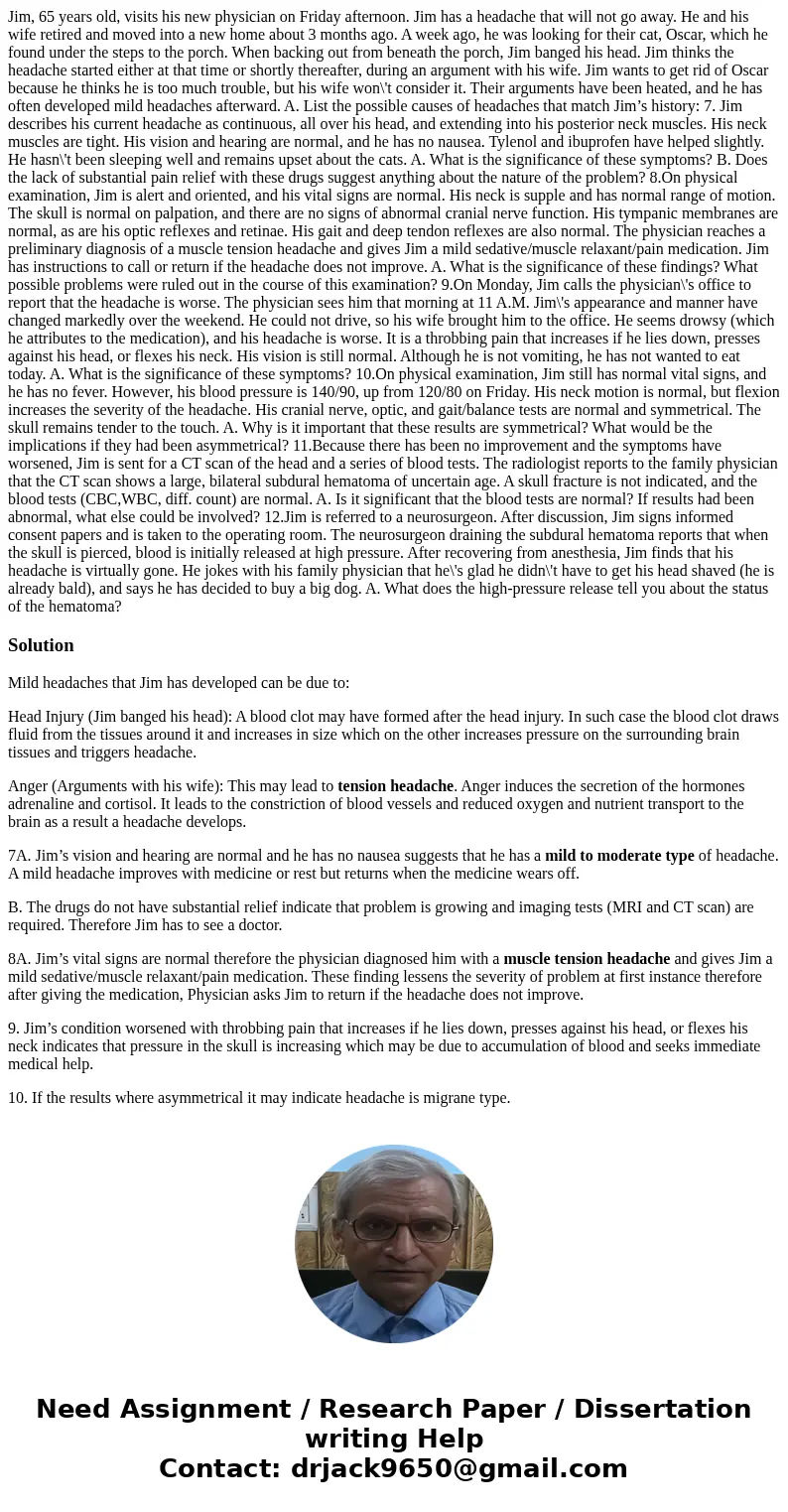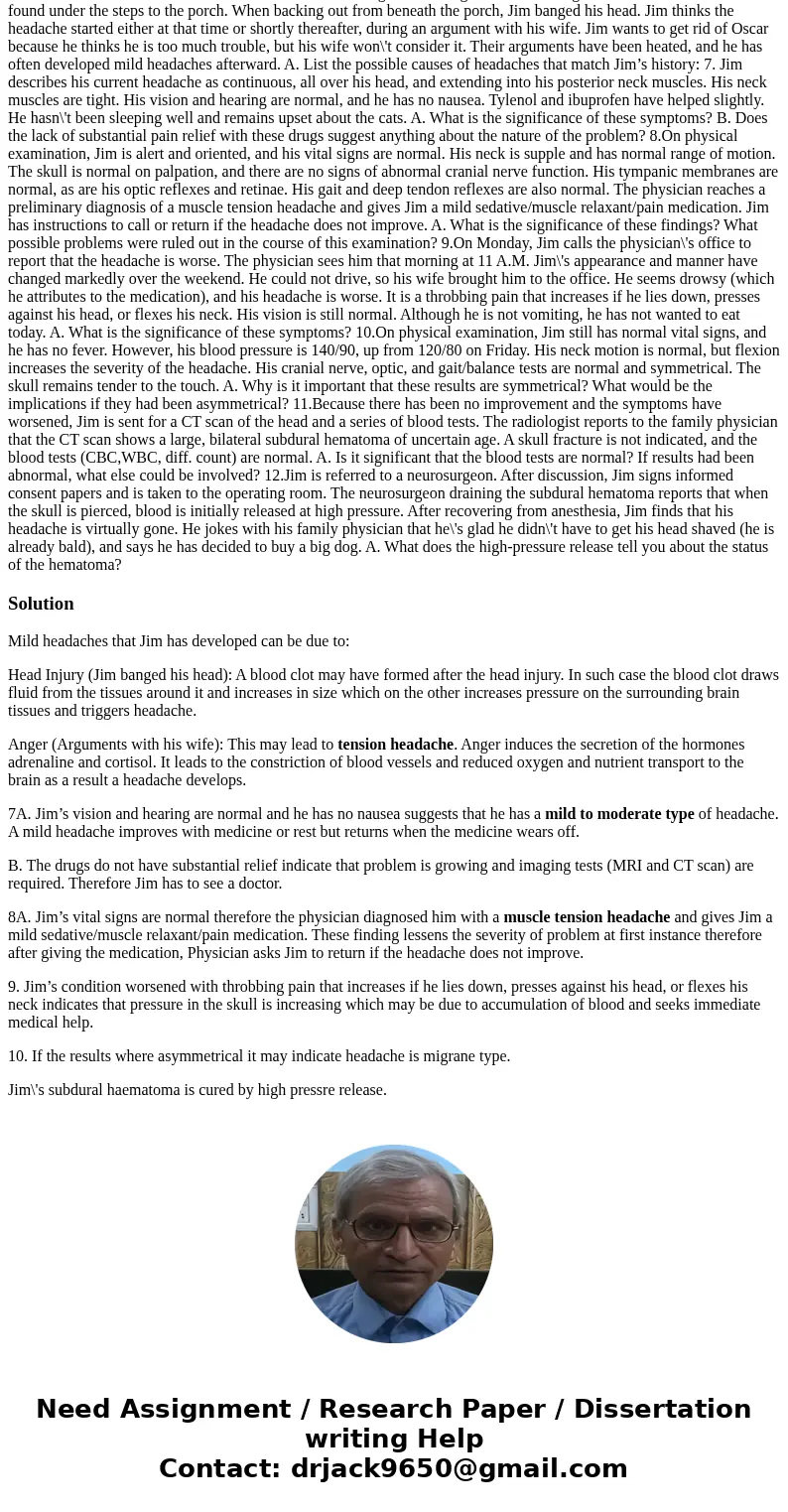Jim 65 years old visits his new physician on Friday afternoo
Jim, 65 years old, visits his new physician on Friday afternoon. Jim has a headache that will not go away. He and his wife retired and moved into a new home about 3 months ago. A week ago, he was looking for their cat, Oscar, which he found under the steps to the porch. When backing out from beneath the porch, Jim banged his head. Jim thinks the headache started either at that time or shortly thereafter, during an argument with his wife. Jim wants to get rid of Oscar because he thinks he is too much trouble, but his wife won\'t consider it. Their arguments have been heated, and he has often developed mild headaches afterward. A. List the possible causes of headaches that match Jim’s history: 7. Jim describes his current headache as continuous, all over his head, and extending into his posterior neck muscles. His neck muscles are tight. His vision and hearing are normal, and he has no nausea. Tylenol and ibuprofen have helped slightly. He hasn\'t been sleeping well and remains upset about the cats. A. What is the significance of these symptoms? B. Does the lack of substantial pain relief with these drugs suggest anything about the nature of the problem? 8.On physical examination, Jim is alert and oriented, and his vital signs are normal. His neck is supple and has normal range of motion. The skull is normal on palpation, and there are no signs of abnormal cranial nerve function. His tympanic membranes are normal, as are his optic reflexes and retinae. His gait and deep tendon reflexes are also normal. The physician reaches a preliminary diagnosis of a muscle tension headache and gives Jim a mild sedative/muscle relaxant/pain medication. Jim has instructions to call or return if the headache does not improve. A. What is the significance of these findings? What possible problems were ruled out in the course of this examination? 9.On Monday, Jim calls the physician\'s office to report that the headache is worse. The physician sees him that morning at 11 A.M. Jim\'s appearance and manner have changed markedly over the weekend. He could not drive, so his wife brought him to the office. He seems drowsy (which he attributes to the medication), and his headache is worse. It is a throbbing pain that increases if he lies down, presses against his head, or flexes his neck. His vision is still normal. Although he is not vomiting, he has not wanted to eat today. A. What is the significance of these symptoms? 10.On physical examination, Jim still has normal vital signs, and he has no fever. However, his blood pressure is 140/90, up from 120/80 on Friday. His neck motion is normal, but flexion increases the severity of the headache. His cranial nerve, optic, and gait/balance tests are normal and symmetrical. The skull remains tender to the touch. A. Why is it important that these results are symmetrical? What would be the implications if they had been asymmetrical? 11.Because there has been no improvement and the symptoms have worsened, Jim is sent for a CT scan of the head and a series of blood tests. The radiologist reports to the family physician that the CT scan shows a large, bilateral subdural hematoma of uncertain age. A skull fracture is not indicated, and the blood tests (CBC,WBC, diff. count) are normal. A. Is it significant that the blood tests are normal? If results had been abnormal, what else could be involved? 12.Jim is referred to a neurosurgeon. After discussion, Jim signs informed consent papers and is taken to the operating room. The neurosurgeon draining the subdural hematoma reports that when the skull is pierced, blood is initially released at high pressure. After recovering from anesthesia, Jim finds that his headache is virtually gone. He jokes with his family physician that he\'s glad he didn\'t have to get his head shaved (he is already bald), and says he has decided to buy a big dog. A. What does the high-pressure release tell you about the status of the hematoma?
Solution
Mild headaches that Jim has developed can be due to:
Head Injury (Jim banged his head): A blood clot may have formed after the head injury. In such case the blood clot draws fluid from the tissues around it and increases in size which on the other increases pressure on the surrounding brain tissues and triggers headache.
Anger (Arguments with his wife): This may lead to tension headache. Anger induces the secretion of the hormones adrenaline and cortisol. It leads to the constriction of blood vessels and reduced oxygen and nutrient transport to the brain as a result a headache develops.
7A. Jim’s vision and hearing are normal and he has no nausea suggests that he has a mild to moderate type of headache. A mild headache improves with medicine or rest but returns when the medicine wears off.
B. The drugs do not have substantial relief indicate that problem is growing and imaging tests (MRI and CT scan) are required. Therefore Jim has to see a doctor.
8A. Jim’s vital signs are normal therefore the physician diagnosed him with a muscle tension headache and gives Jim a mild sedative/muscle relaxant/pain medication. These finding lessens the severity of problem at first instance therefore after giving the medication, Physician asks Jim to return if the headache does not improve.
9. Jim’s condition worsened with throbbing pain that increases if he lies down, presses against his head, or flexes his neck indicates that pressure in the skull is increasing which may be due to accumulation of blood and seeks immediate medical help.
10. If the results where asymmetrical it may indicate headache is migrane type.
Jim\'s subdural haematoma is cured by high pressre release.


 Homework Sourse
Homework Sourse